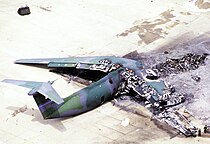Green Ramp disaster

Wreckage of the C-141 Starlifter
destroyed by the accident. |
|
| Accident summary | |
|---|---|
| Date | March 23, 1994 |
| Summary | Mid-air collision |
| Site |
Pope AFB, North Carolina, U.S. |
| Total fatalities | 24 (on ground) |
| Total injuries (non-fatal) | over 100 |
| First aircraft | |
| Type | F-16D |
| Operator | U.S. Air Force |
| Registration | 88-0171 |
| Crew | 2 |
| Survivors | 2 |
| Second aircraft | |
| Type | C-130E |
| Operator | U.S. Air Force |
| Registration | 68-10942 |
| Third aircraft | |
| Type | C-141B |
| Operator | U. S. Air Force |
| Registration | 66-0173 |
The Green Ramp disaster was a 1994 mid-air collision and subsequent ground collision at Pope Air Force Base in North Carolina. It killed twenty-four members of the U.S. Army's 82nd Airborne Division preparing for an airborne operation. It was the worst peacetime loss of life suffered by the division since the end of World War II.
The "Green Ramp" is the large north-south parking ramp at the west end of Pope AFB's east-west runway, used by the U.S. Army to stage joint operations with the Air Force. Several buildings sit along its western edge, including Building 900, the building housing the Air Force operations group. A personnel shed ("pax shed", a large open-bay building) sat next to Building 900, which the Army used to prepare troops for parachute drops. A large grassy area, where troops could stage before drops, lay between the two buildings. Behind the area, several concrete mock-ups of the backs of Air Force cargo aircraft had been constructed, where troops could rehearse their drop procedures.
On the day of the accident, about 500 paratroopers from adjacent Fort Bragg were in the pax shed, the concrete mock-ups or resting in the grassy area. The personnel came from three division units, the First Brigade Combat Team, 504th Infantry Regiment, and 505th Infantry Regiment. While the jumpers prepared to board several C-130 and C-141 aircraft parked on Green Ramp, the sky was filled with F-16, A-10, and C-130 aircraft conducting training.
...
Wikipedia
